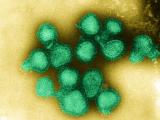Nov 23, 2004 (CIDRAP News) – The Food and Drug Administration (FDA) found serious problems at the Chiron Corp. flu vaccine plant in England in 2003 but failed to follow up in time to prevent the loss of half of the US vaccine supply with the plant's shutdown by British regulators last month, a Democratic congressman charged last week.
After reviewing FDA documents, Rep. Henry Waxman, D-Calif., said the FDA also failed to respond properly when Chiron reported in August 2004 that several lots of flu vaccine from the Liverpool plant were contaminated.
"If FDA had acted differently—by issuing an official warning letter, re-inspecting the facility, and responding aggressively to the August 2004 contamination—the flu vaccine shortage might have been avoided or mitigated," Waxman said in a 13-page memo. The shortage was triggered by the loss of up to 48 million doses of vaccine that Chiron was expected to supply.
Waxman, ranking minority member of the House Committee on Government Reform, distributed his memo at a Nov 17 committee hearing at which Crawford testified. The memo is based on a review of more than 1,000 pages of FDA documents dealing with the agency's oversight of the Chiron flu vaccine plant. The FDA provided the documents in response to a request from Waxman and the committee chairman, Rep. Tom Davis, R-Va.
Acting FDA Commissioner Lester M. Crawford acknowledged in congressional testimony that the FDA did not reinspect the Chiron plant until after British authorities shut it down. But, according to a Nov 17 New York Times report, he said the problems found last year were unrelated to the contamination in this year's vaccine. "The proof of that is that the 2003 vaccine production was completed on schedule and none of it was condemned," he was quoted as saying.
Committee Chairman Davis also defended the FDA. In a statement prepared for the hearing, he said the contamination problems this year were not foreshadowed by those found in the 2003 inspection. He also asserted that the FDA's response to the contamination reported in August was hindered by Chiron's delay in reporting on its own investigation of the problem. Davis also said the reason the FDA had no advance knowledge of British authorities' decision to close the plant was that British law bars agencies from sharing commercial information with other governments without the consent of the involved buiness.
The key allegations in Waxman's memo include the following:
- The FDA found serious and widespread problems at the Liverpool plant (then owned by Powderject Corp. and later bought by Chiron) in June 2003. Problems included defects in 20 areas of vaccine manufacture and high levels of bacterial contamination in several lots of vaccine after a filtration step that was supposed to remove most bacteria.
- Problems revealed in the June 2003 inspection recurred in 2004 and contributed to the closure of the plant. After the British suspended the plant's license in October, the FDA inspected it again and subsequently cited "bioburden" problems that had not been corrected since the 2003 inspection.
- After the 2003 inspection, the FDA decided to ask the company to correct the problems voluntarily, even though the inspection team initially had recommended official enforcement action.
- The FDA didn't send its final report on the June 2003 inspection to Chiron until June 2004, 9 months after it should have been sent. Manufacture of the 2004 vaccine supply was well under way by then.
- After the 2003 inspection, the agency never inspected the plant again until after British authorities shut it down. Shortly after the 2003 inspection, Chiron officials asked to meet with the FDA to review their response plan, but the FDA ignored the request.
- The FDA took a "passive" approach after Chiron notified it Aug 25 that millions of doses of vaccine were contaminated. Instead of sending inspectors, the agency relied on weekly conference calls with Chiron to monitor the company's remedial efforts. FDA officials never asked Chiron or the British government about British regulatory activity.
The memo says that FDA officials met with the committee staff Nov 15 and acknowledged that some of the problems noted in 2003 were "the same as or relevant to" the problems that occurred this year. But the officials said that the contamination problems this year were worse and more widespread than in 2003 and that an increase in the plant's output this year contributed significantly to the worsening of conditions. The officials said the FDA decided not to take enforcement action against the plant in 2003 because conditions there seemed to be improving rather than deteriorating.
Crawford, in his prepared statement to the committee, said the FDA first found problems at the Liverpool plant in a 1999 inspection and issued a warning letter at the time. Inspections in 2001 and 2003 showed that conditions were improving but some problems remained, he said. He added that the company's plans to correct the deficiencies appeared adequate.
After Chiron reported in August that eight lots of vaccine were contaminated, the company told FDA it had found the cause of the contamination and that it was confined to the eight lots, according to Crawford. On Sept 28, a company official assured a Senate committee that Chiron would be able to supply 46 million to 48 million doses, he said.
Crawford reported that the FDA had no knowledge of the British Medicine and Healthcare Products Regulatory Agency (MHRA) decision to close the Chiron plant until it was announced Oct 5. The head of the MHRA said the agency had no legal authority to notify the FDA of its decision in advance, Crawford said.
Crawford promised that the FDA will carefully analyze Chiron's plans to correct the Liverpool plant's problems and will thoroughly inspect the plant after corrective actions are taken, probably in February or March of 2005.
Davis, in defending the FDA, said in his prepared statement for the hearing, "While some issues at the facility continued from 2003 until September of 2004, Chiron’s license suspension was not based on contamination in flu vaccine lots or other issues addressed in previous inspections. It would be inappropriate to imply that problems at the Chiron facility in 2003 recurred in 2004 and contributed to the closure of the facility." Chiron, FDA, and MHRA all blame this year's problems on a systemic "lack of manufacturing oversight and execution," he stated.
Davis said that after vaccine contamination was found in August, Chiron told the FDA it would do an internal investigation and report on it by Oct 4. As it turned out, the company gave its report to the MHRA Sept 24 but did not send it to the FDA until after the MHRA suspended the plant's license on Oct 5, Davis said. FDA officials told Davis's staff that if they had received the report sooner, they would have reinspected the plant sooner, Davis reported.
The committee chairman rejected the charge that the FDA took a passive approach to Chiron after Aug 25. "All documents and meetings confirm that FDA followed routine protocol in responding to Chiron's initial contact with the FDA and continued to follow protocol with each step the agency took after August 25th," he stated.
A statement prepared by Davis's staff labeled Waxman's memo "extremely misleading" and "another partisan attack" on the Bush administration. The statement says Waxman ignored explanations that the FDA, Chiron, and MHRA provided concerning their documents and actions.
Davis also expressed optimism that Chiron will be able to make flu vaccine next year. He said the MHRA is "extremely pleased" with Chiron's remediation plan and will inspect the plant in late December to assess the company's progress.



















